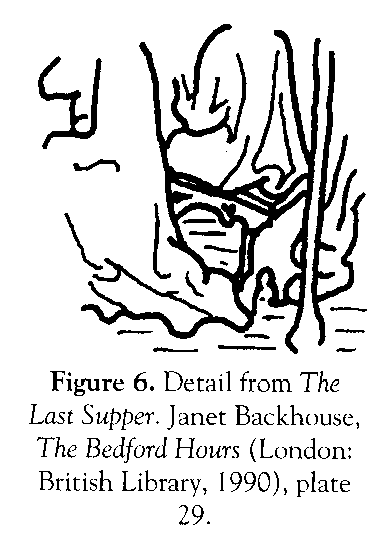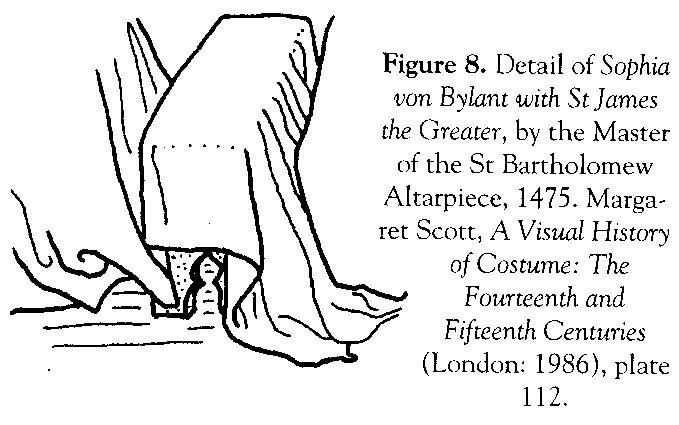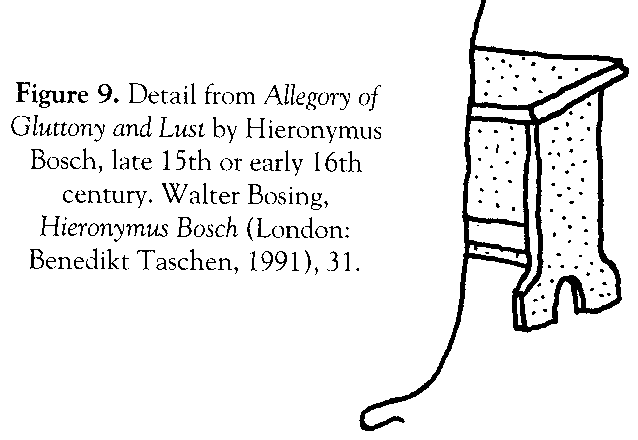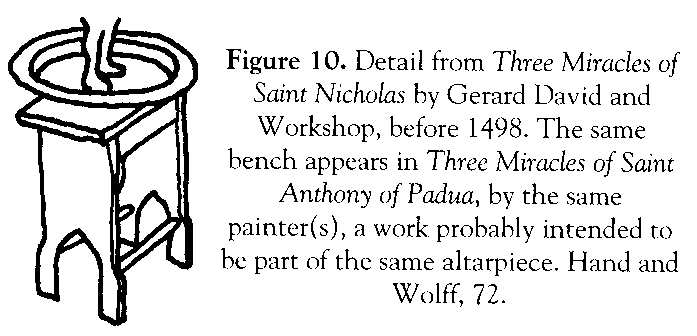In the last five years splendid medieval pavilions have replaced blue plastic
tarps at tourneys and camping events. The use of medieval furniture, however,
has lagged somewhat behind this trend. Although a few craftsmen are making fine
medieval and Renaissance furniture, most of us still sit on director's chairs at
events. This article is aimed at making some medieval seating more accessible.
Medieval furniture can demand a lot of skill and workmanship. Some medieval
furniture does not work well in a Society environment, where we must pack all
our goods in our cars before and after an event. There is no reason to resign
ourselves to director's chairs, however, as some medieval seating was quite
simple and can be easily made by anyone who can use a drill and a saw.
This article describes how to build a simple Gothic-style bench. The
materials are very inexpensive - around ten dollars or so. The skills needed to
make this bench are not very demanding, as the design is quite simple and does
not require much experience with woodworking. Complex tools are not needed. The
bench that results can be packed as a relatively flat set of boards. Best of
all, the result is both attractive and medieval.
Brief Notes on History
The bench described here is a simple slab-ended stool with a decorative
underframe.1 Both vertical and angled supports (legs) existed in
period, although the vertical supports seem to be more common. Examples of this
design of backless stool appear throughout the fifteenth and sixteenth century
in paintings and manuscript illustrations. I do not know of any examples of this
style of bench dating from earlier than the fourteenth century, because
manuscript illustrations are generally of little use before the rise of
realistic portrayals of mundane objects in the fifteenth century, and surviving
examples of actual furniture from before 1400 are rare. Clear examples of this
type of bench appear throughout the fifteenth and sixteenth centuries in western
Europe. Penelope Eames mentions slab-ended stools in the Bayeux tapestry,2
but all the furniture there is shown full-front and stylized, so her
interpretation is uncertain.
The stool design is very simple, and is closely related to that of the
slab-ended or six-board chest. Slab-ended chests were common throughout the
Middle Ages, and examples survive from the tenth century until the seventeenth.3
Note that slab-ended chests would also serve as seating, so it seems reasonable
to suppose the existence of slab-ended stools from the tenth century on.
Construction
In the directions that follow I leave it up to you whether to use screws or
wooden dowels to fasten the bench scat to the rails. Screws are modern, and
would not have been used; they are also much better fasteners and are easier to
use effectively.
If you decide to use screws, 2" drywall screws work well on pine. Be
sure to countersink the screws, and also make sure to pre-drill pilot holes for
them or else the wood will split. After you have placed the screws, you should
plug the countersunk screw holes with a wood dowel to hide the screw heads. Cut
off the plug at the scat level using a wood chisel, and then sand the plug
flush. A properly countersunk and plugged screw hole will look identical to a
dowel.
| If you decide to use dowels, 1/4" diameter hardwood
dowels are best. 2" long will probably do the trick. Glue the hole
carefully before inserting the dowel. As dowels are less sturdy than
screws, you may want to use more than two to fasten each rail to the
bottom of the bench seat (perhaps up to five per rail). Leave a little
of the dowel standing up out of the hole so that you can cut it off at
the seat level and sand it flush.
Even the dowel construction method is not necessarily the way these
stools would have been built in period. Extant stools of this design are
on display in the Cloisters (Figures 1, 2), but I have not yet been able
to visit them to determine how the understructure is fastened to the
bottom of the seat.
Further, there are many examples of benches where the top part of the
leg pieces is extended in two tenons that pierce the bench seat (as seen
in Figures 1, 2, 3 and 4) in two through-mortises.
This design is more stable than the one I describe, but requires four
mortise-and-tenon joints. I encourage you to explore this technique, but
I have deliberately avoided using it here to keep this bench design
simple. |
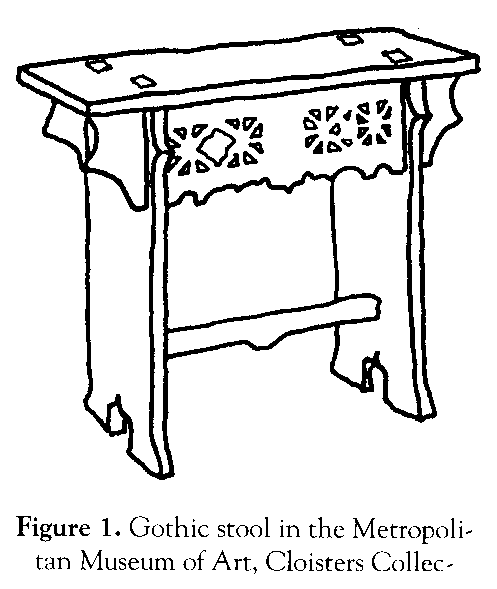 |
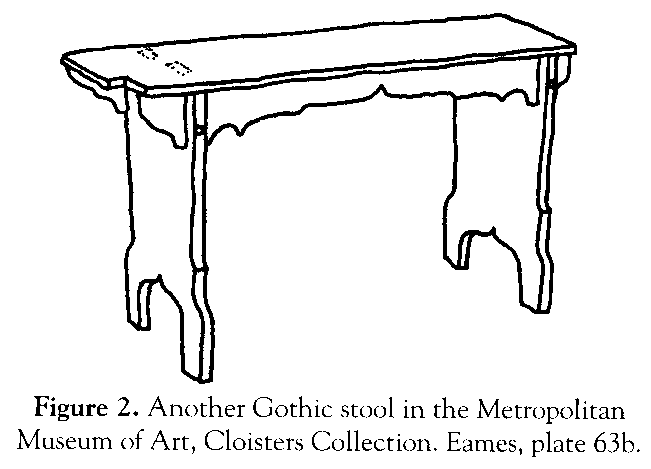 |
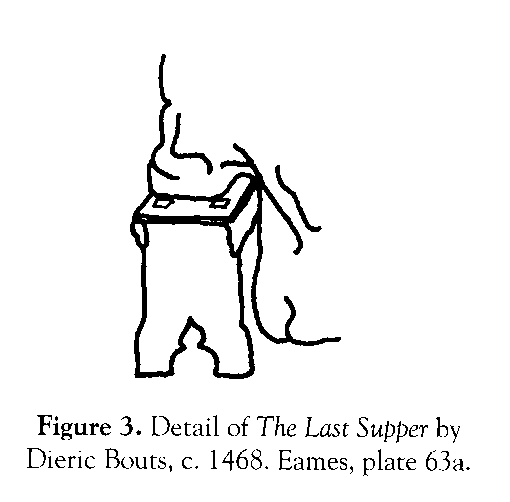 |
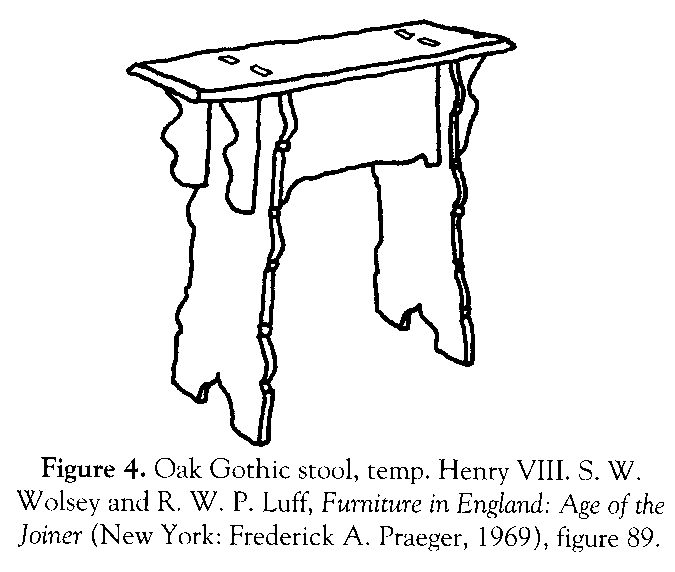 |
|
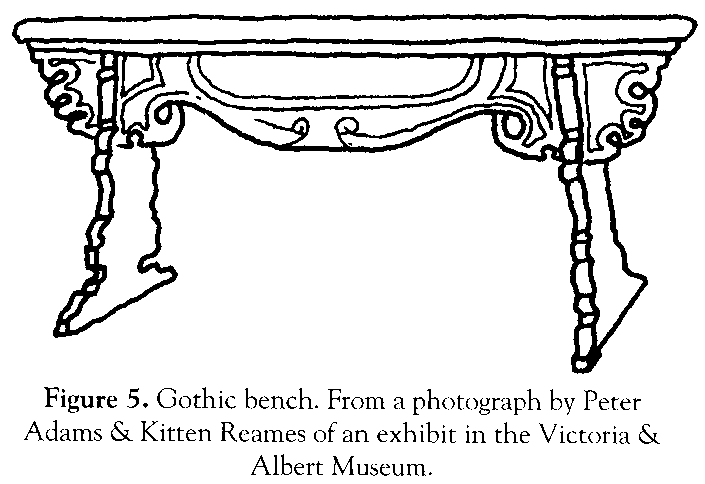
In this design the leg and the rails interlock with each other. This method
is clearly used in all the extant benches examined (Figures 1, 2, 4, 5). In some
benches in manuscript illustrations, the leg piece is lapped by the rail
(Figures 3, 6, and 7) or the rail ends at the leg (Figures 9 and 1 0 - perhaps
significantly, both of these benches also have an additional runner at the
bottom of the legs for reinforcement).
Materials
6' long 1x12" board
6' long 1x4" board
wood glue
1/4" diameter dowels or 2" long drywall screws
The benches I've constructed from this pattern have been made in pine Knotty
pine is very inexpensive - the two boards - needed for one bench cost me only
ten dollars. In poplar the materials might cost around twenty dollars; oak,
maple or nicer hardwoods would cost more (that amount of red oak would cost
sixty dollars at my normal source). In harder woods the work will take slightly
longer.
Any of the common woods for furniture could have been used for these benches.
Oak was the favored wood for furniture in the Middle Ages and Renaissance.
Poplar and pine were also commonly used, but almost any hardwood available would
be a possibility. Elm, walnut and cypress are among examples of other woods used
for medieval and Renaissance chests and chairs.4
Decoration
A little decorative scrollwork will make the difference between a
crude-looking bench and one that is really attractive. Visual sources and
surviving benches show a variety of designs, from very simple (Figures 8 and 9)
to extremely ornate (Figure 5). Pierced decorative designs were also used, as
shown in Figures 1, 5 and 6.
Some of the benches illustrated have a simple runner down near the base of
the bench to further support the legs (Figures 1, 9, 1 1). One example shows a
bench with two runners at the feet (Figure 10).
Instructions
1. Cut the 6' long lxl2" board into three pieces: one 36" long (for
the seat of the bench) and two 16" long (for the legs). See Figure 12.

2. Cut the 6' long 1x4" board into two pieces, both
35" long. This will form the rails. See Figure 13.

3. Pencil the decorative scrollwork patterns onto the rails and the legs.
Also pencil the locking slots onto the top of the leg pieces and the bottom of
the rails. The locking slots must be exactly 3/4" wide (the thickness of
your boards). On the legs the locking slots are exactly 2" deep; on the
rails they are exactly 1 1/2" deep. The decorative scrollwork dimensions
are not crucial so I have left them out. Be creative. Thin pieces will be
fragile, however - try to leave as much thickness on the rails near the locking
slots as possible.
4. Using a jigsaw, scroll saw or band saw, cut along the pencilled lines for
the decorative cuts and the vertical parts of the locking slots.
5. Using a 3/4" chisel, chop the waste out of the locking slots.
6. Check the locking slots for fit. File the slots until they fit closely.
You should not need to force the legs and top together - eventually this will
cause the wood to split and ruin your bench. If the legs fit too loosely your
bench will wobble and will not be as sturdy.
7. Place the seat upside down on a flat surface. Put the rails and legs
together and place the assembly on the bench, so you have the whole bench
together (don't glue anything yet!) upside down. Carefully center the assembly
on the bottom of the bench seat, then mark along the rails with a pencil between
the legs of the bench.
8. Take the legs and rails off the seat. Drill four holes through the seat
centered on the rails, about two inches from where the rails attach to the legs.
See Figure 14.
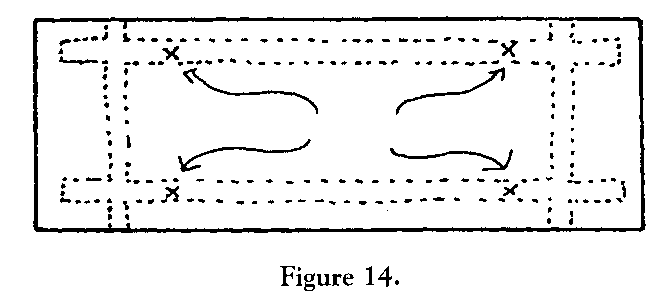
9. Put the leg and rail assembly together right-side-up on the floor (still
unglued). Turn the seat over and reposition it on the rail/leg assembly (making
sure the holes you have just drilled are directly over the rails), then drill
into the rails using the holes in the bench as a guide for the drill.
10. Spread glue on the top of the rails (the part that touches the seat),
then screw or dowel the rails to the bottom of the seat. Clamp the rails until
the glue is dry. Cut off the protruding ends of the dowels with the wood chisel
(or, if you used screws, countersink the screw heads and use a plug to hide the
screw head, then cut off the protruding end of the plug). Clean up any visible
glue waste. Note that you do not glue the legs to the rails - they simply slide
in. This allows you to remove the legs to pack the bench flat in a car.
11. Finally, sand the surface of the bench, use files to clean up the
decorative saw cuts if necessary, and finish the bench. A couple of layers of
wax (butcher-block wax or bowling alley wax are best) is a good finish; modern
finishes like polyurethane will also work. You can paint the bench if you wish.
Postscript
| The bench described above has a weakness. The carved
scrollwork ends of the rails sometimes split off (see Figure 15). This
happens to be a medieval problem also - some of the surviving benches
show similar damage. There are two ways to avoid this problem. |
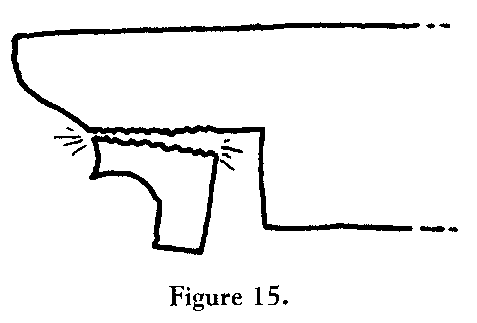 |
| The first method is to put a screw or dowel through the
end of the rail to reinforce it. Be careful not to let it poke out
through the scrollwork, as shown in Figure 16. |
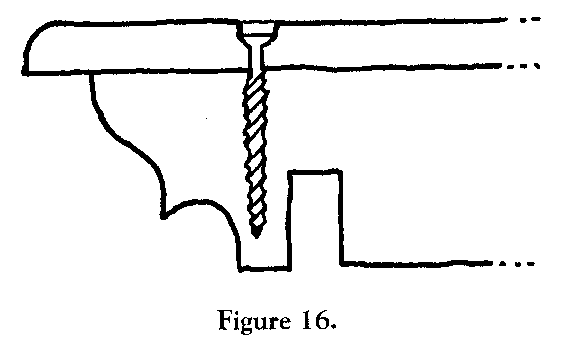 |
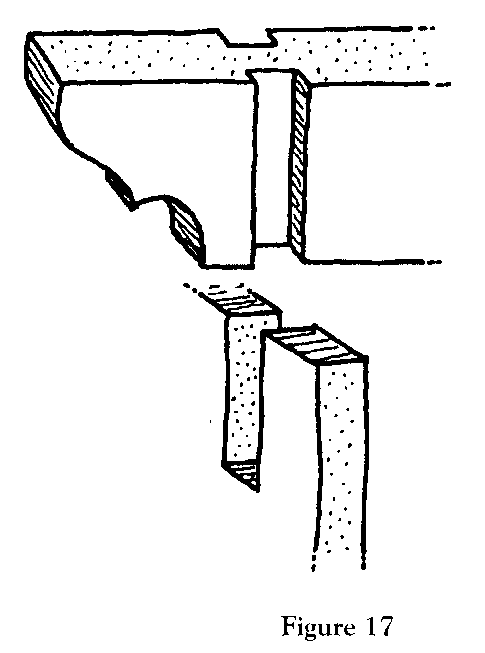 |
The second technique was suggested by my
friend Master Badouin MacKenzie. Instead of having the legs and rails
have matching locking slots, make two shallow dados (3/4" wide,
1/8" deep, and all the way across the 3 1/2" width of the
rail) in either side of the rail at each joint and a single locking slot
3 1/2" long and 1/2" wide in the legs for each joint. This
will reinforce the rails. This technique requires more woodworking
expertise and tools than the other method. The dados can be made by hand
with a 3/4" chisel. If you have a table saw and dado blade, or a
router table, you will be able to make the joints much faster. See
Figure 17. |
Notes
1. Penelope Eames, Furniture in England , France and the Netherlands from
the Twelfth to the Fifteenth Century (London: Furniture History Society, 1977),
209. Figures 1 and 2 in this article show extant vertical-foot benches; Figures
4 and 5 show extant slanted-foot benches.
2. Eames, 206.
3. Eames, 138.
4. Eames, 135.
David Kuijt (2801 Ashmont Terrace, Silver Spring, MI 20906) is a
graduate student working towards a Ph.D. in computer science at the University
of Maryland. Dafydd ap Gwystl (Earl, Laurel, Knight, Sea Stag, Pearl,
Golden Dolphin, Yew & Sinew, Fellow of the University of Atlantia) is an
early fifteenth-century Welsh knight seeking glory, fame and fine clothing,
fighting in France, Burgundy and Atlantia. He has more hats than any other noble
in the kingdom of Atlantia.

Return to the Greydragon library





